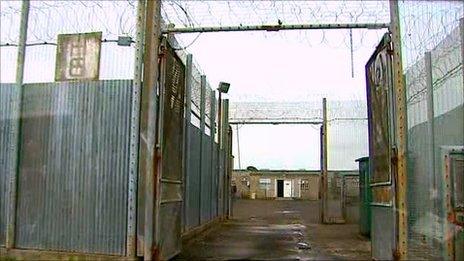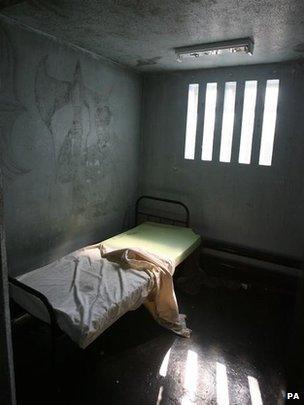NI state papers: New light on IRA prison escape
- Published

The entrance to H-6 inside the former maximum security prison
The mass escape of 38 IRA prisoners from the Maze Prison, near Belfast, on 25 September 1983, in which a prison warder was stabbed to death, is detailed in previously confidential files released by the Public Record Office in Belfast.
Like many files in this year's releases, that relating to the prison escape is partially closed to 2069.
Confidential reports prepared for the Secretary of State Jim Prior in the wake of what was described as the biggest prison escape in Irish history, shed new light on the wounding of a prison officer and the role of a British military guard during the unfolding event.
In a report on the events of that dramatic Sunday, penned the following day, W J Kerr, director of prison operations in Northern Ireland, described how at 16:45 BST he was informed of "an incident at the Maze".
He immediately proceeded to the prison where he "was informed that H7 Block had been taken over by armed prisoners who had hijacked the kitchen lorry and had proceeded to the main gate".
He then went to the Royal Victoria Hospital to speak to the wife of officer Adams who had been wounded in the head, and then to visit the family of officer Ferris who had been stabbed to death during the escape.
Diary of events
On his return to the Maze that evening he learned that 15 escapees had been recaptured, leaving 23 IRA men still "unlawfully at large".
There follows a diary of the events on that Sunday.
The day began normally with prisoners unlocked for breakfast and exercise.
At 11:15 BST Fr Rooney, the Roman Catholic chaplain, celebrated Mass in the H Block with 54 prisoners in attendance.
Dinner was served at 12:15 BST after which all the prisoners were returned to their cells.
At 14:00 BST, as the day prison staff resumed duty, there were 126 prisoners in H Block 7 and 24 warders prior to the 'incident'.
Suddenly at 14:45 BST prisoners in H Block 7 overpowered staff on duty and took control of the block.

Gerry Kelly released a book about the 1983 Maze prison breakout earlier this year
Various weapons were used including guns.
The prisoners commandeered the prison meals delivery van and 38 prisoners forced the prison officer driver to drive the van from the block through segment gates one and eight to the prison main gate.
The prisoners then overpowered the staff on duty at the gate and, although eventually the alarm was raised, they managed to get out of the prison proper.
The prisoners at this point disappeared and fled in different directions.
Among the prisoners in H7 were Gerry Kelly, aged 30, (the current Sinn Féin MLA for North Belfast) and Brendan "Bik" McFarlane, who had been a spokesman for the hunger strikers during the 1981 hunger strike.
Kelly had been convicted at Winchester in 1973, along with the Price sisters and Hugh Feeney, for setting off car bombs in London; in all he had made four previous escape attempts.
McFarlane, then 31, described in the file as "a Provisional IRA (PIRA) leader deeply involved in the organisation", was sentenced to five life terms for the 1975 bombing of the Bayardo Bar on the Shankill Road in which five people died.
The sequence of events at the prison began at 14:45 BST when prisoner Mead asked to see a senior prison officer.
"On entering the office Mead produced a gun. (Officer) Smylie attempted to disarm him and in the struggle Mead struck Smylie across the face with the gun."
Overpowered
At this point "prisoner Storey entered the principal officer's office carrying a gun and pointed it at Mr Smylie's head. Storey then took charge. Mr Smylie was tied up and Mr George ordered to sit and answer the telephone in a normal manner."
Meanwhile, other officers were being overpowered and tied up throughout the H Block.
The report continues: "Officer Leak was in the toilet when he heard two shots. He left (to see) prisoner 58 Kelly (Gerry Kelly, MLA) pointing a pistol into the control room. Kelly turned the gun on Leak and forced him into the officers' tea room. Leak was tied up and hooded."
Kerr added at this point: "This would establish that prisoner Kelly shot officer Adams who was on duty in the control. It is not clear if the control grille was locked before Mr Adams was shot."
As the IRA inmates gradually seized control of the wings, prisoner Kerr approached the grille (security) gates and forced the officer on duty to hand over the keys.
The officer was then taken to D Wing, stripped and tied up.
By this stage the prisoners were within sight of the 'lock gates' where prison officer McFall was on duty.
McFall was approached by Bik McFarlane who said he had been "sent to clean the sentry box" beside the gates.
The report continues: "McFall opened the inner gate with McFarlane when two prisoners appeared from the side of the gate. Each of these prisoners had guns... McFall was taken to the officers' tea room and hooded, stripped and tied."
Meanwhile, officer McLaughlin was on duty as kitchen van driver and at 15:25 BST had passed through the lock gates of H Block to deliver afternoon tea.

A prison cell in one of the H Blocks - the jail closed in 2000
Kerr reported what happened next to the Secretary of State, Jim Prior: "As officer McLaughlin started to unload the meal from the van, prisoner Storey put a gun to his head and forced him into the medical inspection room. Whilst there he was threatened by prisoner Kelly who told him to do as he was told or he would be 'blown away'. McLaughlin was then forced to drive the van from the block to the main gate through the inner gates."
According to the report the van proceeded through the first segment gate unchallenged.
Conclusion
At the next gate - "the admin gate" - officer Ireland, who was on duty, identified the van driver as officer McLaughlin and, as a result, "the van was allowed to proceed through this gate without being searched".
The plan was now reaching its conclusion, as the report describes: "After the van left the admin gate the driver was forced to take the vehicle to the transport parking area where most of the uniformed prisoners disembarked making their way to the tally lodge (at the main gate of the jail). They rushed into the gate area where they succeeded in taking over the controls of the main gate."
However, Kerr stressed, the staff in the tally lodge "resisted strongly and in the ensuing affray one officer was stabbed and died shortly afterwards" while a number of other staff were injured.
"In the meantime the driver was forced to take the van to the inner main gate where it was permitted to enter the 'airlock area'. The outer main gate was then opened by a prisoner at the controls, but by this time the alarm had been raised and two officers sitting in their cars outside the gate drove into the area, blocking the exit."
Other staff returning from their meal breaks attempted to prevent the escape, one of them receiving a gunshot wound to the leg.
In the resulting melee three inmates were prevented from leaving the gate area, but the others "ran across country chased by members of staff".
A further seven, including a prisoner called Murray, who was wounded by an army sentry, were apprehended.
'At large'
By 11:00 BST on 26 September the security forces had captured another six inmates.
At the time of the report on 26 September, 21 inmates remained "unlawfully at large".
In his conclusion, Kerr highlighted a number of aspects of the IRA escape that gave him cause for concern.
In particular, the fact that the inmates were in possession of firearms suggested that they and their supporters outside were able to breach the security measures at the Maze.
He was particularly alarmed at the ease with which prisoners were able to gain access to the secure entrance into the blocks and the main gates.
He also questioned how the escaping prisoners were allowed to drive a hijacked vehicle through two segment gates without being challenged, and why five officers in H Block 7 were permitted to be off their posts at the same time and that "an apparently abnormal number of inmates" had been in the central area at the time of the takeover.
Notwithstanding these concerns, the director of prison operations recorded his appreciation of the "acts of considerable courage" by his officers in resisting the escape attempt.
The escape was the focus of a meeting between a DUP delegation, led by Rev Ian Paisley and Peter Robinson, to the secretary of state on 26 September 1983.
The DUP MPs claimed that the escape could only have been organised with assistance from prison officers and expressed incomprehension that "the guards on the control towers had not fired on the escaping prisoners".
Dr Paisley went on to demand the resignation of the minister in charge of prisons, Nicholas Scott.
Dr Paisley's allegations prompted a memo to the secretary of state from an NIO official, P W J Buxton, on 28 September 1983 on the reaction of the soldiers who formed a prison guard force of 150 men at the prison.

A huge security operation was launched after the escape of 38 IRA inmates
Rules
He reported that the sentry on duty in the watchtower on the main gate was the only member of the military guard immediately involved in the actual breakout at the gate; he had shot an escaper whom he had seen shoot a prison officer.
Buxton was clear on the rules governing the response of the military guard to any escape attempt: the position of a soldier shooting escapers is quite clear; the yellow card applies.
Thus, unless the escaper is presenting a direct threat to life, or has just killed or injured someone and there was no other way of arresting, he is not authorised to shoot.
The Army would not shoot escapers who are simply escaping... such action would not be the "minimum force" that the card calls for.
The official told Prior that there was "no question of recent prosecutions of members of the security forces for murder having made the sentry uncertain of his legal position" though he was undoubtedly "inhibited by the uncertainty as to who was an escaper and who was a prison officer, as some prisoners were in prison officer clothing and some of the (officers) in civilian clothes."
He revealed that as soon as the alarm was raised, "39 Brigade scrambled the city helicopter and implemented Operation Greyhound, a Northern Ireland-wide vehicle checkpoint plan".
Meanwhile, within minutes of the escape the RUC chief constable had implemented Operation Bolt resulting in NI-wide checkpoints.
He noted that prison officers apprehended eight escapers at the scene while 11 others were arrested in the following days by the RUC and Army.
Five loaded handguns and two imitation firearms were recovered, one on the escaper who was wounded by the sentry.
- Published12 September 2011
- Published8 June 2011
- Published5 May 2011